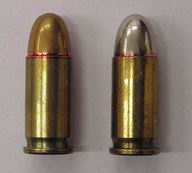.32 ACP
 7.65 mm Browning rounds. Left: standard FMJ. Right: military round with nickel coating. | ||||||||||||
| Type | Pistol | |||||||||||
| Place of origin | ||||||||||||
| Production history | ||||||||||||
| Designer | John Browning | |||||||||||
| Manufacturer | Fabrique Nationale | |||||||||||
| Produced | 1899 | |||||||||||
| Specifications | ||||||||||||
| Case type | Semi-rimmed, straight | |||||||||||
| Bullet diameter | .309 in (7.8 mm) | |||||||||||
| Neck diameter | .336 in (8.5 mm) | |||||||||||
| Base diameter | .337 in (8.6 mm) | |||||||||||
| Rim diameter | .358 in (9.1 mm) | |||||||||||
| Rim thickness | .045 in (1.1 mm) | |||||||||||
| Case length | .680 in (17.3 mm) | |||||||||||
| Overall length | .984 in (25.0 mm) | |||||||||||
| Ballistic performance | ||||||||||||
| ||||||||||||
| Test barrel length: 4 in Source(s): Federal Cartridge [1] | ||||||||||||
The .32 ACP (Automatic Colt Pistol) pistol cartridge is a semi-rimmed, straight-walled cartridge developed by firearms designer John Browning, for use in the FN M1900 semi-automatic pistol. It is also known as the 7.65x17mm Browning SR or 7.65 Browning. Introduced in 1899 by Fabrique Nationale,[2] the cartridge was first used in the Browning M1900.
History
John Browning engineered most modern semi-automatic pistol mechanisms and cartridges. As his first pistol cartridge, the .32 ACP needed a straight wall for reliable blowback operation as well as a small rim for reliable feeding from a box magazine. The cartridge was a success and was adopted by dozens of countries and countless governmental agencies. It has the distinction of being the cartridge that arguably both started World War I and ended World War II in Europe. Gavrilo Princip fired a .32 ACP to assassinate Franz Ferdinand and Adolf Hitler reportedly committed suicide with an engraved .32 ACP Walther PPK.
Design
The .32 ACP designed for blowback semi-automatic pistols which lacked a breech locking mechanism; the relatively low power made it a practical blowback round. It is still used today primarily in compact, inexpensive pistols. Cartridges in .32 ACP are also sometimes used in caliber conversion sleeves, also known as supplemental chambers, for providing an alternative pistol caliber carbine functionality in .30-caliber hunting rifles.
Performance
The .32 ACP is compact and light, but short ranged, having marginal stopping power.[3] Weapons chambered in it are often valued for their compactness and light weight relative to larger caliber pistols, particularly for concealed carry use. While able to kill, the small, low-velocity bullets do not incapacitate people readily. Hollowpoint ammunition has been available for decades and is known to increase stopping power, if only marginally.
In Europe, the .32 ACP is more widely accepted than in America having a long history of use for civilians as well as military and police agencies.[2] The cartridge increased in popularity due to modern compact concealed carry pistols chambered for it such as the Kel-Tec P-32, Beretta Tomcat and the Seecamp LWS 32. This increase in popularity has led many ammunition manufacturers to develop new, better-performing loads for the cartridge.
Synonyms
- 32 Auto (typical designation in America)
- .32 Browning Auto
- 7.65 x 17 mm
- 7.65 x 17mmSR (SR designating Semi-Rimmed)
- 7.65 mm Browning (typical designation in Europe)
Prominent firearms chambered in 32 ACP
- FN M1900
- FN Model 1910 and 1910/22
- Colt Model 1903 Pocket Hammerless
- Mauser HSc
- Sauer 38H
- Walther PPK
- Beretta Tomcat
See also
References
- ^ Federal Cartridge Co. ballistics page
- ^ a b Barnes, Frank C. (2006) [1965]. Skinner, Stan (ed.). Cartridges of the World (11th Edition ed.). Iola, WI, USA: Gun Digest Books. p. 289. ISBN 0-89689-297-2.
{{cite book}}:|edition=has extra text (help) - ^ Hornady (2003). Hornady Handbook of Cartridge Reloading. vol I (6th Edition ed.). Grand Island, NE, USA: Hornady Mfg Co. p. 710.
{{cite book}}:|edition=has extra text (help)
